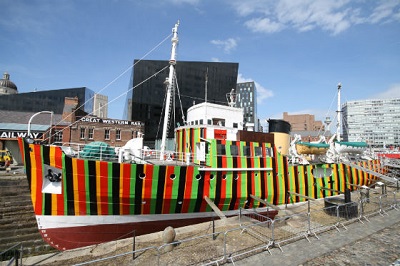Ships Become Contemporary Art Forms
The CMA CGM Magellan, a 365 meters long vessel, has been transformed into a work of art by world-renowned artist, JR.
With this initiative, JR wanted to conclude his project «Women are Heroes» initiated in 2008, when he photographed the eyes of extraordinary women all around the world. The picture that was assembled on the CMA CGM Magellan is the eyes of Elizabeth, a Kenyan woman living in the Kibera slums, in Nairobi.
JR owns the biggest art gallery in the world.
He exhibits freely in the streets of the world, catching the attention of people who are not typical museum visitors. JR creates “Pervasive Art” that spreads uninvited on the buildings of the slums around Paris, on the walls in the Middle-East, on the broken bridges in Africa or the favelas in Brazil. People who often live with the bare minimum discover something absolutely unnecessary. And they don’t just see it, they make it. Some elderly women become models for a day; some kids turn artists for a week.
After these local exhibitions, the images are transported to London, New York, Berlin or Amsterdam where people interpret them in the light of their own personal experience. As he remains anonymous and doesn’t explain his huge full frame portraits of people making faces, JR leaves the space empty for an encounter between the subject/protagonist and the passer-by/interpreter.
In a separate celebration of art, the German sculptor Tobias Rehberger is due to unveil his dazzled warship in London on 14 July as part of the commemorations marking 100 years since the start of the First World War.
Rehberger's black-and-white geometric design will be applied to the hull of HMS President to commemorate the dazzle camouflage that was invented by the artist Norman Wilkinson and used by the Royal Navy to confuse the German Navy during the war.
Unlike other forms of camouflage, dazzle works not by concealing but by making it difficult to estimate a target’s range, speed and direction. Dazzle was intended primarily to mislead the enemy: each ship’s dazzle pattern was unique in order to avoid making classes of ships instantly recognizable to the opposition.
The newly dazzled ship is docked at the Victoria Embankment and will be on view until late 2015.
 This commission follows one in Liverpool by the Venezuelan optical artist Carlos Cruz-Diez. One of the major figures of contemporary art, Cruz-Diez, was commissioned to paint a version of a dazzle ship in partnership with National Museums Liverpool.
This commission follows one in Liverpool by the Venezuelan optical artist Carlos Cruz-Diez. One of the major figures of contemporary art, Cruz-Diez, was commissioned to paint a version of a dazzle ship in partnership with National Museums Liverpool.
Liverpool Biennial’s dazzle ship is part of Monuments from the Future: a new commissioning initiative between Tate Liverpool and the Biennial which invites artists and architects to bring large-scale imaginary monuments from the future into the present.
In order to fulfill this paradoxical task, artists will collaborate with professional futurologists (social scientists who predict possible future scenarios) to determine possible future circumstances and set of events for which a new monument can be imagined and produced.
This project will slowly turn Liverpool into a sci-fi sculpture park making use of Liverpool’s industrial archaeology to celebrate its possible new futures.
The pilot ship Edmund Gardner vessel is conserved by Merseyside Maritime Museum and has been be dazzled by Cruz-Diez in a dry dock adjacent to Albert Dock Liverpool.

